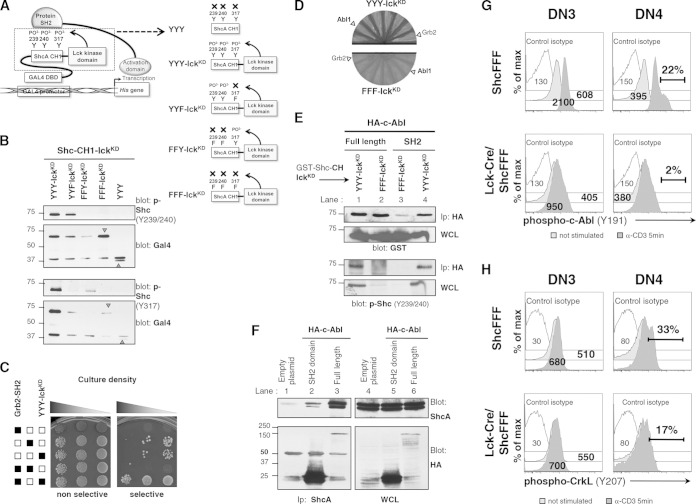FIG 7.
c-Abl can interact with phosphorylated ShcA and promote migration of immature thymocytes. (A) Schematic of modified yeast two-hybrid assay. Fusion of the p56Lck kinase domain (lckKD) to the CH1 region of ShcA allows p56Lck kinase to phosphorylate tyrosine residues Y239, Y240, and Y317 within the ShcA CH1 region. Fusion of the Gal4 DNA binding domain (DBD) to the ShcA CH1 region allows this protein to interact with the Gal4 promoter. Prey proteins, such as Grb2, can interact with the phosphorylated residues on CH1 domain from ShcA. This brings the Gal4 activation domain into proximity to activate transcription of the gene encoding His, thus rescuing the His auxotrophy, and permits growth of transformed yeast cells on selective medium. (B) The Grb2 SH2 domain interacts specifically with phosphorylated Shc-CH1 in yeast. HF7c yeast cells were transformed with the indicated constructs, including Grb2-SH2 pv16 as a positive control, to detect protein interactions. After transformation, yeast cells were plated on SD-LW plates (nonselective; selects only for the presence of plasmid) or SD-LWH plates with 10 mM 3-AT (selective; requires interaction of bait and prey proteins for growth). (C) HF7c yeast cells were transformed with the indicated Shc-CH1-lckKD variant. Yeast cell lysates were blotted for phospho-ShcY239/Y240 or for phospho-ShcY317 and for Gal4 expression. (D) HF7c yeast cells containing either the Shc-CH1 domain with the kinase domain of lck (Shc-CH1-lckKD; referred to here as YYY-lckKD) or tyrosine-mutated Shc-CH1 (Shc-CH1FFF-lckKD; referred to here as FFF-lckKD) transformed with positive clones from the screen. (E and F) 293T cells were transiently transfected with the indicated constructs. Cell lysates were immunoprecipitated with anti-HA–agarose beads and immunoblotted with anti-GST to detect Shc-CH1-lckKD proteins or with anti-phospho-ShcA (Y239/240) and anti-HA to detect c-Abl constructs. WCL, whole-cell lysates. (G) Phospho-c-Abl (Y191) signal from the unstimulated conditions or anti-CD3-stimulated conditions (5 min) in DN3 and DN4 subpopulations of thymocytes from control (ShcFFF) and Lck-Cre/ShcFFF mice. Data represent mean fluorescence values or percentages of phospho-c-Abl-positive cells. The data represent a pool of 3 mice and a pool of 4 mice, respectively, and are similar to data obtained from a separate pool of control and Lck-Cre/ShcFFF mice (n = 2). (H) CrkL phosphorylation upon CD3 stimulation in Lck-Cre/ShcFFF and control ShcFFF DN3 and DN4 thymocytes (3 mice per genotype).

